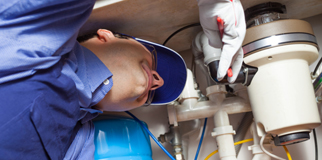Useful Techniques for Repairing a Dripping Garbage Disposal
Useful Techniques for Repairing a Dripping Garbage Disposal
Blog Article
The article author is making a few great annotation relating to Why Is My Garbage Disposal Leaking From the Bottom? as a whole in this content below.

Waste disposal unit are essential kitchen area appliances that assist in getting rid of food waste successfully. Nevertheless, a leaking waste disposal unit can be a frustrating and unpleasant problem to handle. Luckily, several leakages can be fixed conveniently with a couple of straightforward actions. In this short article, we will discuss how to repair a dripping garbage disposal successfully.
Intro
Garbage disposals are set up under kitchen area sinks and are created to shred food waste right into smaller pieces, permitting it to pass through the pipes system easily. While these gadgets are typically trustworthy, leakages can happen in time as a result of deterioration, loose links, or damages to the device.
Common Reasons For Leaks in Waste Disposals
Worn Seals and Gaskets
Seals and gaskets play a vital duty in avoiding water from leaking out of the waste disposal unit. Gradually, these components can degrade, resulting in leakages around the disposal device.
Loose Connections
The connections between the waste disposal unit and the pipes system can end up being loosened in time, causing water to leak out throughout procedure.
Splits or Holes in the Disposal Unit
Physical damages to the garbage disposal, such as cracks or openings in the housing, can additionally cause leakages.
Identifying the Source of the Leak
Prior to attempting to deal with a dripping waste disposal unit, it is essential to determine the source of the leak. This can normally be done with visual assessment or by conducting basic tests.
Visual Inspection
Examine the garbage disposal system carefully for any kind of signs of water leakage. Pay close attention to areas around seals, gaskets, and link factors.
Evaluating for Leaks
One method to examine for leakages is by running water via the disposal unit and checking for any type of visible indications of leakage.
Tools and Materials Needed for Dealing With a Leaking Garbage Disposal
Before starting the fixing procedure, collect the necessary devices and materials, including a screwdriver, adjustable wrench, plumbing technician's putty, replacement seals or gaskets, and epoxy or patching material for fixing splits or holes.
Step-by-Step Guide to Dealing With a Leaking Waste Disposal Unit
Switch off the Power
Before attempting any kind of fixings, make sure that the power to the garbage disposal device is shut off to avoid the threat of electrical shock.
Situate the Leakage
Recognize the exact place of the leakage and establish the cause.
Tighten up Links
Use a wrench to tighten any type of loose connections between the disposal unit and the pipes system.
Change Seals or Gaskets
If the leakage is due to used seals or gaskets, eliminate the old elements and change them with brand-new ones.
Patching Cracks or Holes
For cracks or holes in the disposal system, use epoxy or a suitable patching product to secure the damaged location.
Examining the Waste Disposal Unit After Repair Work
As soon as the repair is complete, check the garbage disposal by running water with it to make sure that the leakage has actually been fixed.
Preventive Upkeep Tips to Stay Clear Of Future Leaks
To prevent future leaks, it is important to execute regular maintenance on your waste disposal unit. This includes maintaining it tidy, avoiding placing non-food items or tough things down the disposal, and regularly checking for leakages or various other issues.
Conclusion
In conclusion, taking care of a leaking waste disposal unit is a relatively simple procedure that can be completed with basic devices and products. By adhering to the steps laid out in this short article and practicing preventative upkeep, you can keep your garbage disposal in good working problem and avoid costly repair work in the future.
What to Do About a Leaking Garbage Disposal
A leaking garbage disposal often goes unnoticed until you confront a sopping cabinet, a foul-smelling puddle, or an audible drip-drip-drip from the unit. The fix can be frustrating, too, because the leak can stem from a number of components in the system. Fortunately, with a little sleuthing, you can zero in on the leak and—depending on the exact location—stop the icky oozing and repair the component that caused it. Worst case scenario, if it turns out that the garbage disposal must be replaced, installing a new one is a reasonable do-it-yourself task for those with basic plumbing skills. Read on to keep the cash you’d otherwise hand over to a pro.
Prepare to find the leak
Prior to testing the garbage disposal for leaks, unplug it at the wall outlet and turn off the power from the breaker box to prevent electrical shock. Then insert a watertight sink stopper into your sink drain and wipe the unit dry with a clean cloth. In any handy container, mix a few drops of food coloring into a few cups of water, and pour the dyed water onto the sink stopper to help you locate the leak.
Investigate the source
the top, where the disposal meets the sink drain the side, where the dishwasher hose or main drain pipe connects to the disposal or the bottom of the unit Inspect each of these locations while gliding a light-colored rag over the unit; the dyed water will readily show on the rag and reveal the location of the leak. If a leak isn’t immediately apparent, remove the sink stopper and pour a few more cups of dyed water down the sink drain, then check for leaks again. Leaks near the top of the unit are more likely to show themselves while the sink is plugged, while side and bottom leaks are more noticeable while the sink is unplugged.
The metal sink flange that sits directly inside the sink drain is typically sealed around the top with plumber’s putty (a clay-like sealant) and then secured from under the sink with bolts. If the plumber’s putty deteriorates, or the bolts loosen, the flange can no longer form a watertight seal between the sink drain and the disposal—which could cause a leak at the top of the unit.
To reseal the leaky flange, you must first detach the garbage disposal. Start by loosening the screws securing the main drain pipe to the disposal, then loosen the screws in the metal clamp securing the dishwasher hose to the disposal and detach the drain pipe and dishwasher hose from the disposal. Loosen the screws in the mounting ring that connects the disposal to the metal mounting assembly beneath the sink, then pull down the disposal and carefully set it on a clean, dry surface. Loosen the bolts in the mounting assembly with a wrench, then pull down the mounting assembly and set it near the disposal.

I am just very intrigued by The Handy Guide To Fixing Your Garbage Disposal Leaking and I hope you enjoyed reading my blog post. Sharing is caring. You just don't know, you may be doing someone a favor. Thank you for taking the time to read it.
At This Website Report this page